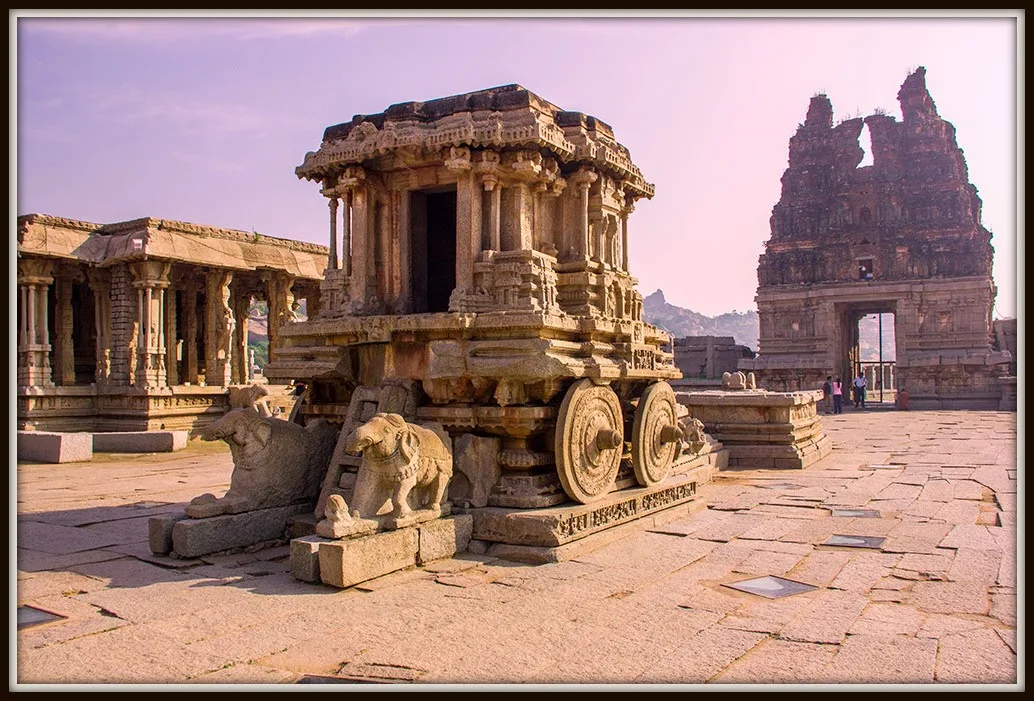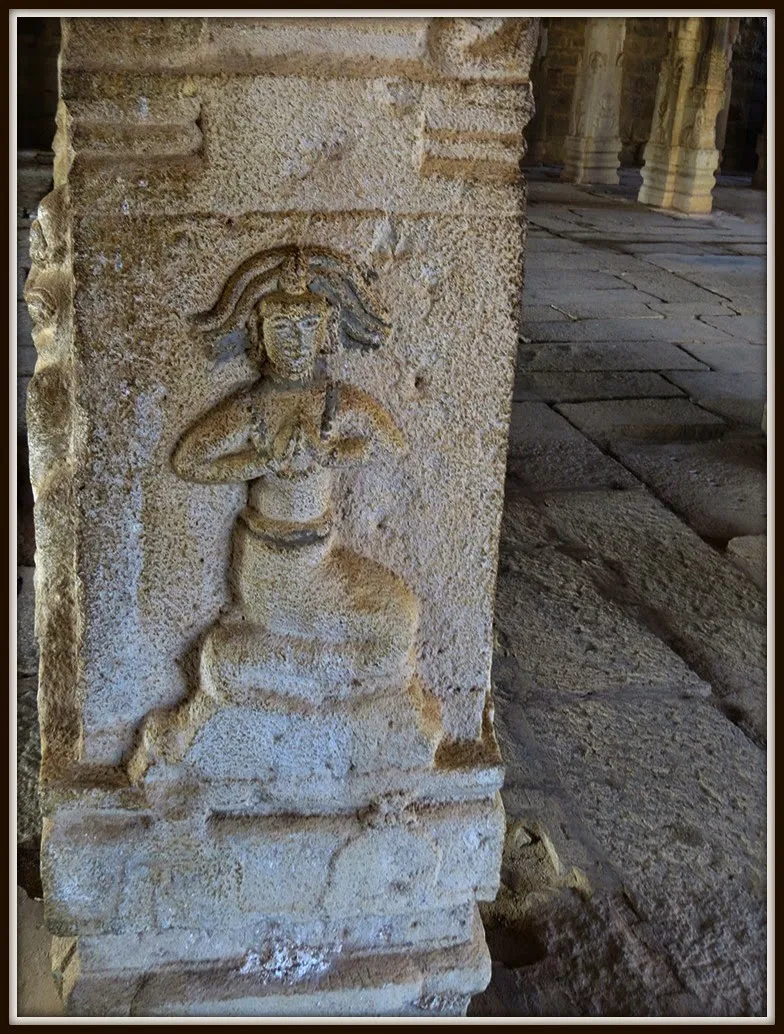One of the most extravagant architectural showpiece in Hampi is the Vittala Temple. You cannot afford to miss this magnificent temple if you visit Hampi. Vittala Temple opens at 8:30 am and the earlier you reach the better it is. As the day rolls out, both the heat and crowd swells.
Once you park your car at the parking, you either have to walk a 1 km stretch or alight on a battery operated car to reach the temple premise. No car is allowed after the designated parking spot. This is done to protect such architectural marvels from further deterioration. The electric cars are all operated by women.
The most famous Stone Chariot is in Vittala Temple. In front of the chariot two elephants are positioned as if they are pulling the chariot. In fact these elephants where brought from elsewhere and positioned here at a later stage. Originally two horses were carved in that position. The tails and the rear legs of the horses can be still seen just behind these elephant sculptures.
There are mantapa or halls on all sides and each of them has intricate carvings and decorations. Some of the paintings can still be seen today on the ceilings. It was believed that at one time the entire Vittala Temple has such beautiful paintings.
The Maha-Mantapa has beautifully carved giant monolithic pillars.Many of the pillars are musical pillars and they produce the musical tones when lightly tapped. What amazing architecture.
Thankfully now tapping of the pillars is strictly prohibited to protect these architectural marvels from breaking down.
The eastern hall which is called the musicians hall is notable for sculptures of musicians on the pillars. The southern halls have the sculptures of the mythical Yali.
The entry fee to Vittala temple is Rs 10 and the same ticket can be used for same day entry at Lotus Mahal.
Once you are just out of the Vittala temple, there will be a huge area on the left . That was the Bazaar; even now known as Vittala Bazaar. One can still see the numerous rock pavilion where mostly people used to set their shops. There is a pushkarini or pond adjacent to Vittala Bazaar.
The road on the right will lead you to the famous King's Balance and the Vishnu Temple. On this 5 metre balance the king used to weigh himself with gold, silver, gems and precious stones and used to distribute those valuables to priests on certain special occasions based on the placement of celestial bodies. Three loops on top of the balance, into which the balance actually hung can be seen even today. Also one of the pillars has the king’s image carved.
We stayed for more than 2 hours at Vittala. Now its hot and time to get back to hotel. On the way back we saw the Ganagitti Jain temple dedicated to the 17th Tirthankara. The temple has a beautiful garden all around it.
Just at the back of the Jain temple is the Bheema's gateway. It is not at all popular but is a very very interesting place. This gateway is a classic example of the Vijayanagara military architecture. The gate got its name from the legendary Bhima, who was famous for his enormous strength and
self esteem. There is a structure of Bhima with a club in one of his hands and a "saugandhika" flower for his beloved wife Draupadi in the other hand.
Also there are carvings of Draupadi tying her hair. Slaying of Kichaka who tried to molest Draupathi is depicted next to it. According to legend, when Kichaka tried to molest Draupadi by pulling her hair she vowed that she will not comb her hair till she gets her revenge. As revenge she wanted to apply Kichaka's blood on her hair. So when Bhima the Great slayed Kichaka he gave Draupadi Kichaka's blood after which Draupadi broke her vow.
The interesting feature of Bhima's gate is its smart design. One cannot cross this archway in a straight line. So this works more like a blind spot for the invading army. Also it’s difficult for the elephant mounted forces to take such quick maneuvers without facing some surprise attacks.
Enough of architecture and history in the morning. Now after a quick lunch and a little rest in our homestay we will head to Daroji.
 |
| Vittala Temple Stone Chariot |
Once you park your car at the parking, you either have to walk a 1 km stretch or alight on a battery operated car to reach the temple premise. No car is allowed after the designated parking spot. This is done to protect such architectural marvels from further deterioration. The electric cars are all operated by women.
The most famous Stone Chariot is in Vittala Temple. In front of the chariot two elephants are positioned as if they are pulling the chariot. In fact these elephants where brought from elsewhere and positioned here at a later stage. Originally two horses were carved in that position. The tails and the rear legs of the horses can be still seen just behind these elephant sculptures.
 |
| Stone Chariot |
 |
| Inside Vittala Temple |
 |
| Colorful painting on the ceiling |
There are mantapa or halls on all sides and each of them has intricate carvings and decorations. Some of the paintings can still be seen today on the ceilings. It was believed that at one time the entire Vittala Temple has such beautiful paintings.
 |
| Hard at work. The first stone chariot photograph was being taken |
 |
| Inside Vittala Temple |
 |
| Stone pillars |
 |
| Carving on the pillar |
 |
| Stone Pillars |
 |
| Carving on pillar |
 |
| Carving at the base of the temple |
 |
| Sculptures on the pillar depicting scene from the Ramanayana |
 |
| Sculpture |
Thankfully now tapping of the pillars is strictly prohibited to protect these architectural marvels from breaking down.
The eastern hall which is called the musicians hall is notable for sculptures of musicians on the pillars. The southern halls have the sculptures of the mythical Yali.
The entry fee to Vittala temple is Rs 10 and the same ticket can be used for same day entry at Lotus Mahal.
Once you are just out of the Vittala temple, there will be a huge area on the left . That was the Bazaar; even now known as Vittala Bazaar. One can still see the numerous rock pavilion where mostly people used to set their shops. There is a pushkarini or pond adjacent to Vittala Bazaar.
The road on the right will lead you to the famous King's Balance and the Vishnu Temple. On this 5 metre balance the king used to weigh himself with gold, silver, gems and precious stones and used to distribute those valuables to priests on certain special occasions based on the placement of celestial bodies. Three loops on top of the balance, into which the balance actually hung can be seen even today. Also one of the pillars has the king’s image carved.
 |
| Temple outside Vittala Temple |
 |
| Large gateway behind Kings Balance |
 |
| Vishnu Temple |
 |
| King's Balance |
 |
| King's Balance |
 |
| Ganagitti Jain Temple |
self esteem. There is a structure of Bhima with a club in one of his hands and a "saugandhika" flower for his beloved wife Draupadi in the other hand.
Also there are carvings of Draupadi tying her hair. Slaying of Kichaka who tried to molest Draupathi is depicted next to it. According to legend, when Kichaka tried to molest Draupadi by pulling her hair she vowed that she will not comb her hair till she gets her revenge. As revenge she wanted to apply Kichaka's blood on her hair. So when Bhima the Great slayed Kichaka he gave Draupadi Kichaka's blood after which Draupadi broke her vow.
 |
| Bheema's Gateway Entrance |
 |
| Carving on the wall depicting scene from the Mahabharata |
 |
| Finding a good spot to photograph |
 |
| Bheema Sculpture |
The interesting feature of Bhima's gate is its smart design. One cannot cross this archway in a straight line. So this works more like a blind spot for the invading army. Also it’s difficult for the elephant mounted forces to take such quick maneuvers without facing some surprise attacks.
Enough of architecture and history in the morning. Now after a quick lunch and a little rest in our homestay we will head to Daroji.

No comments:
Post a Comment